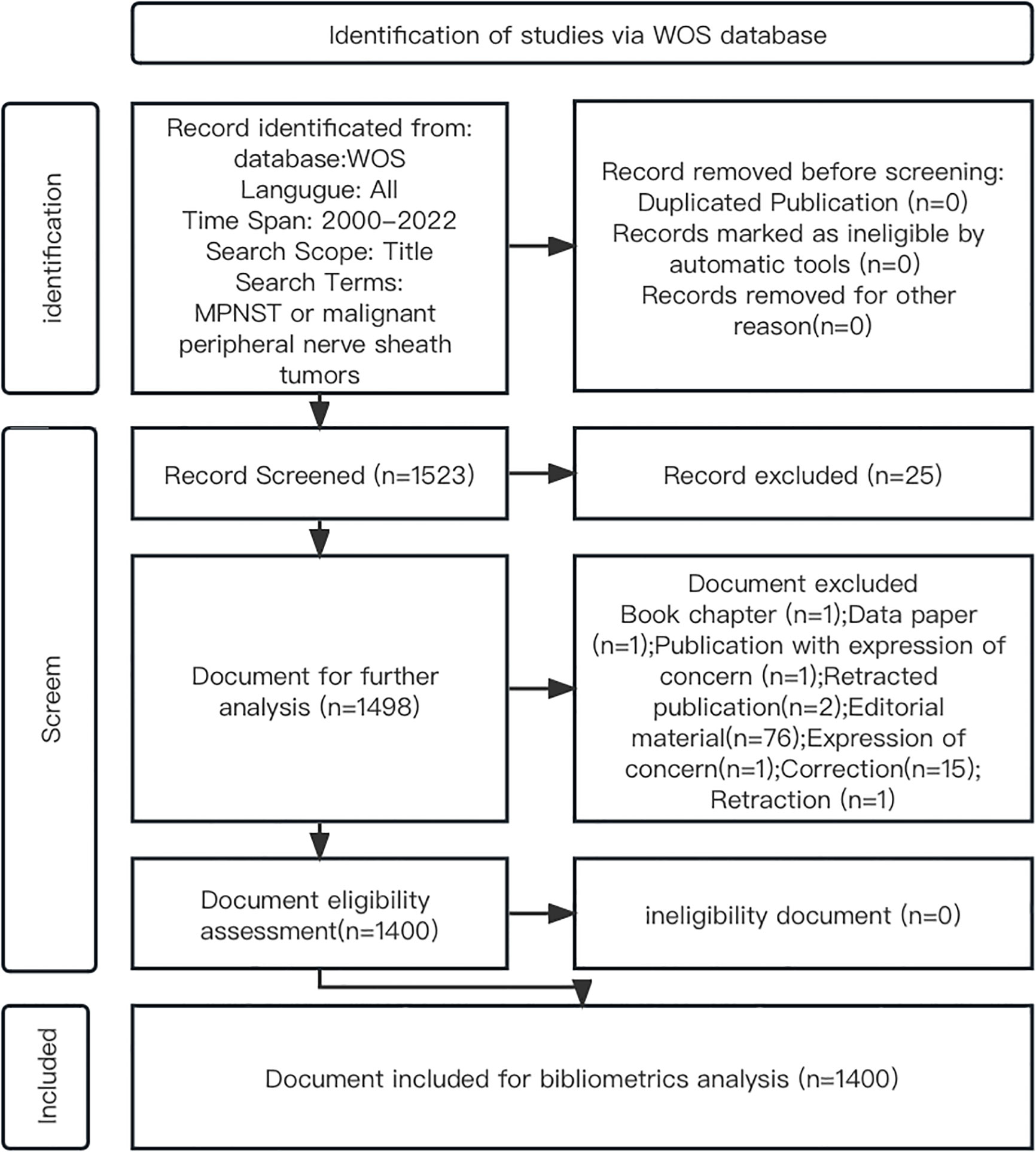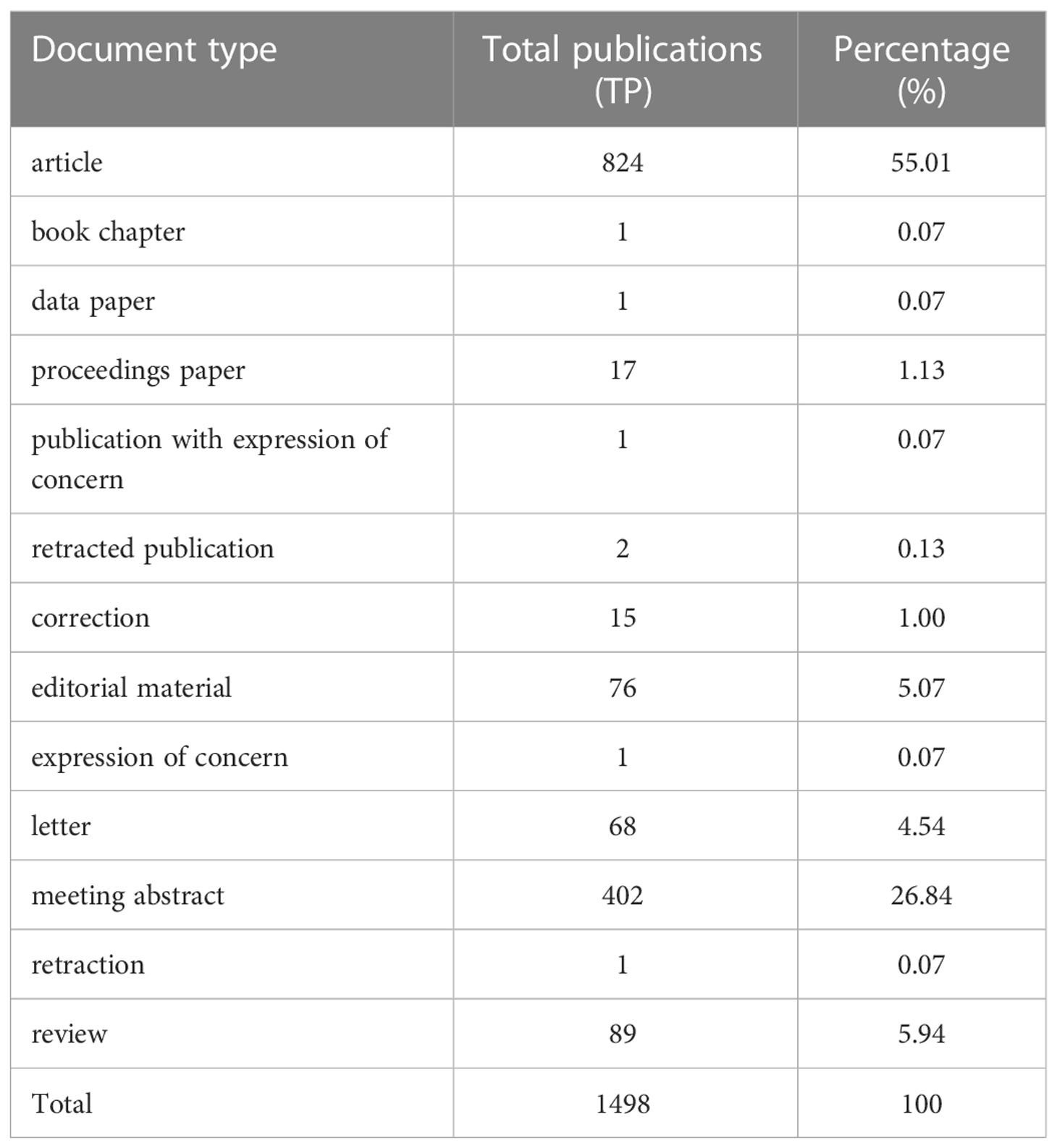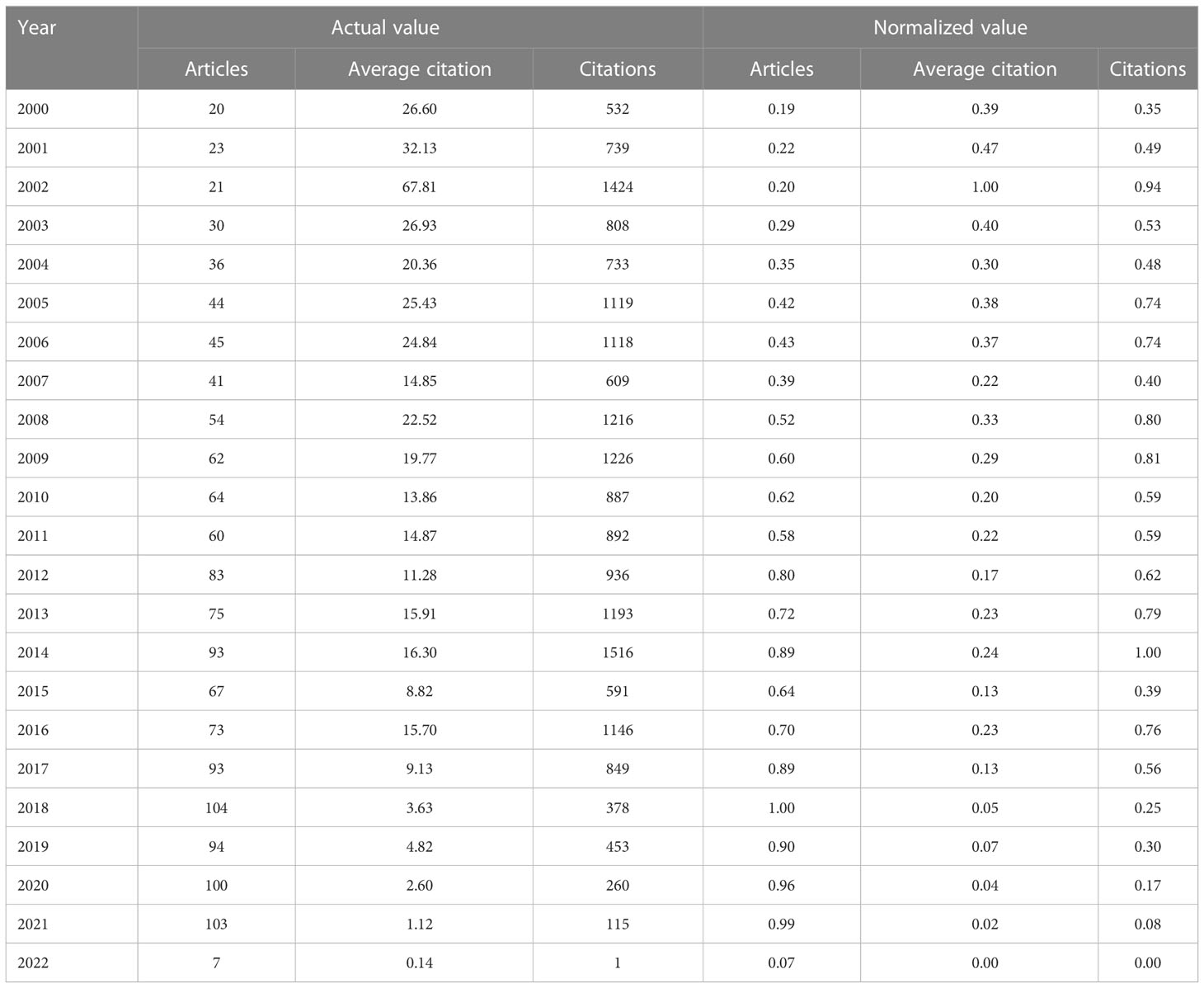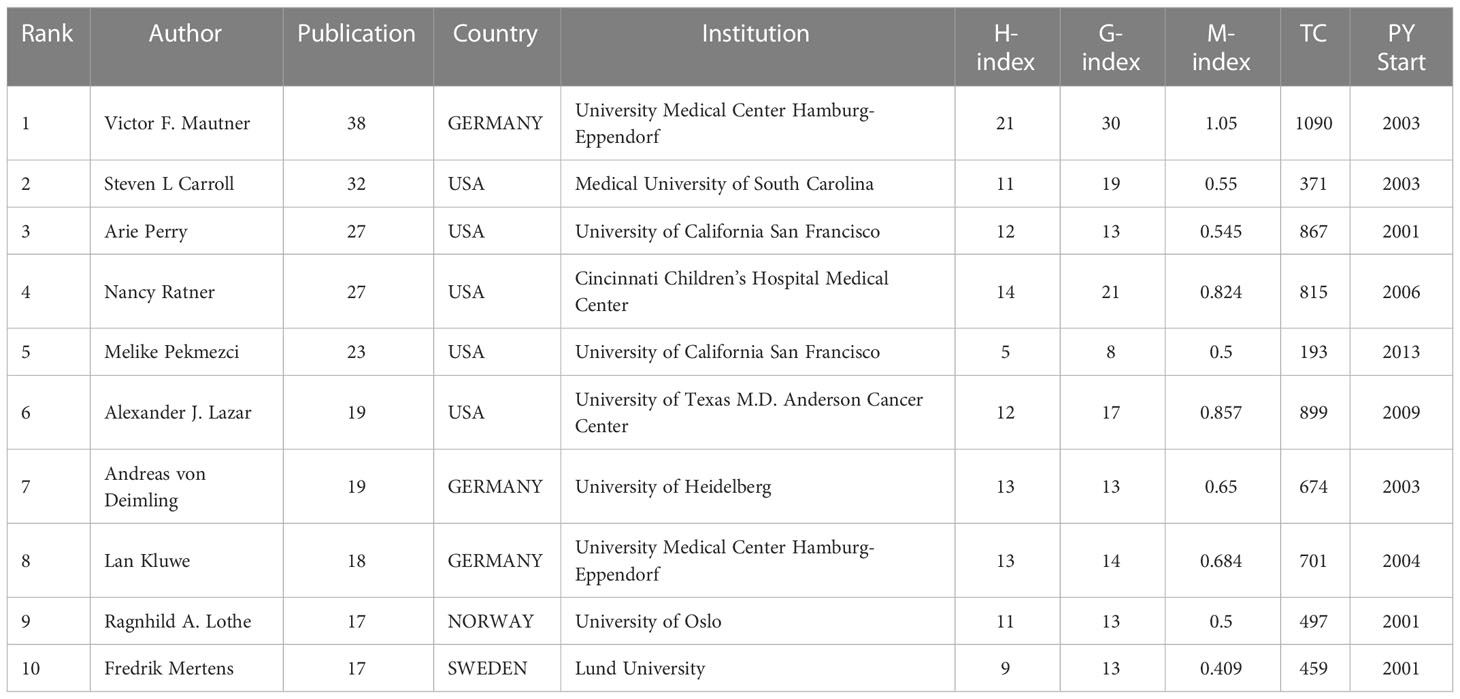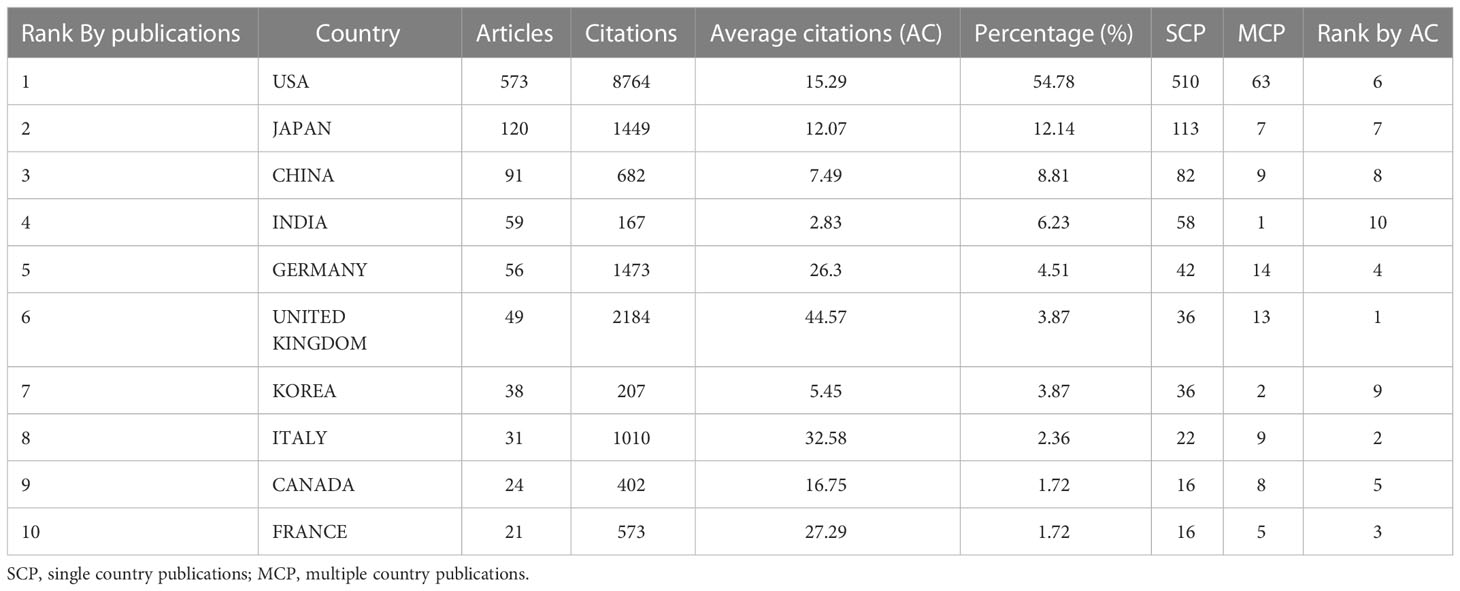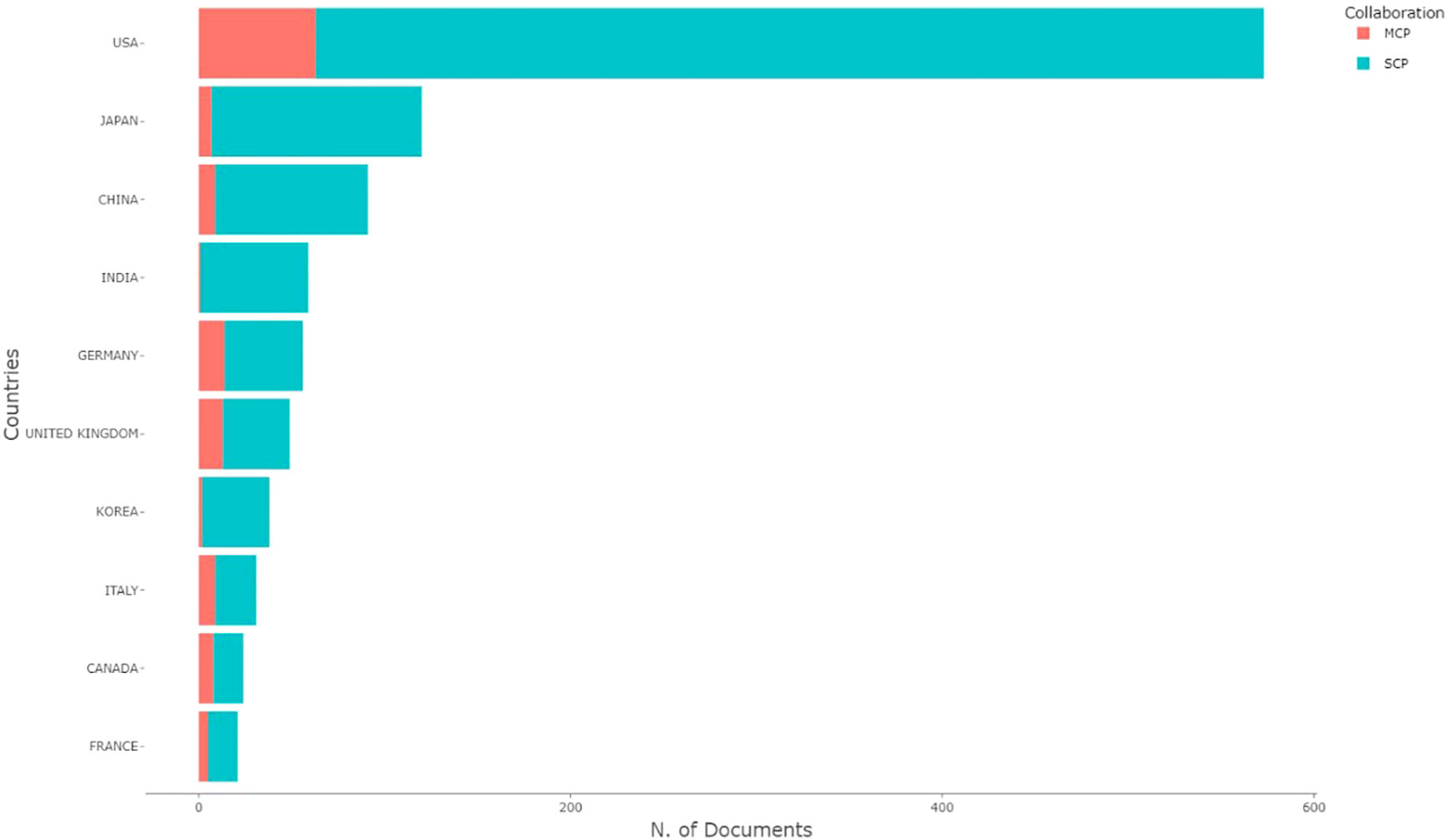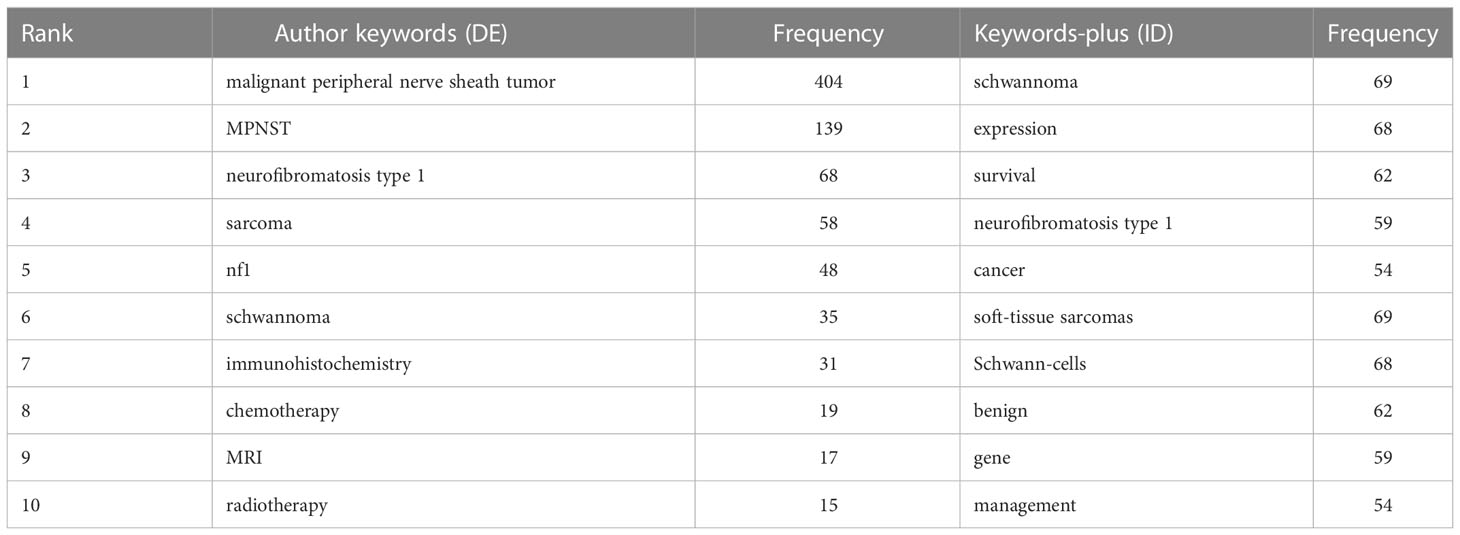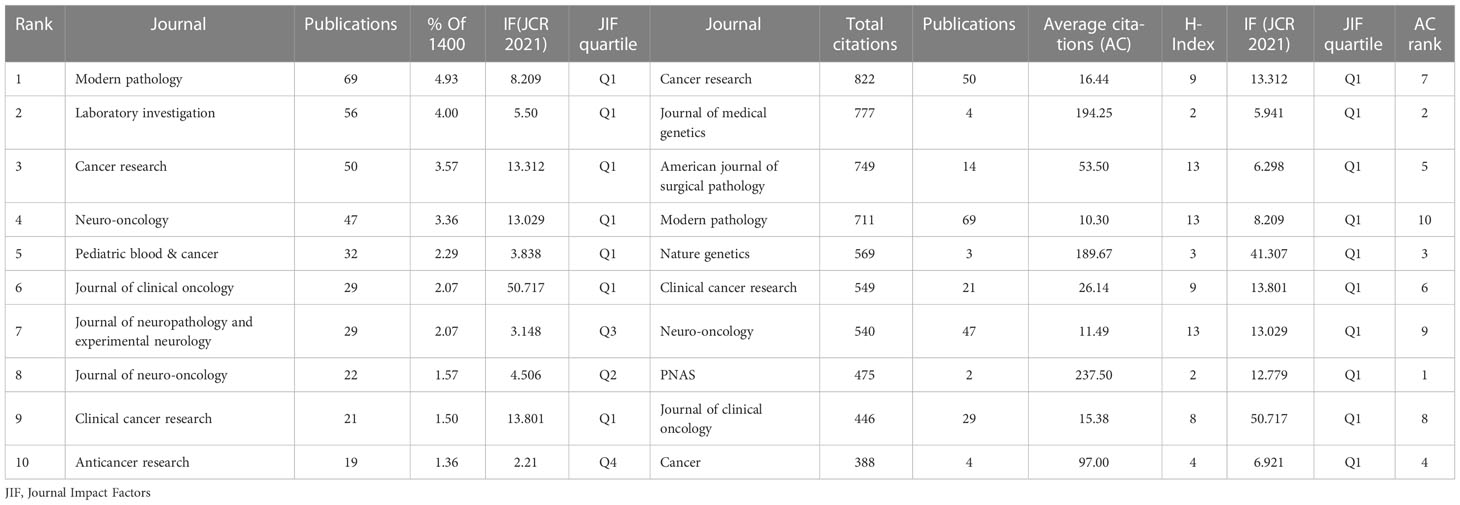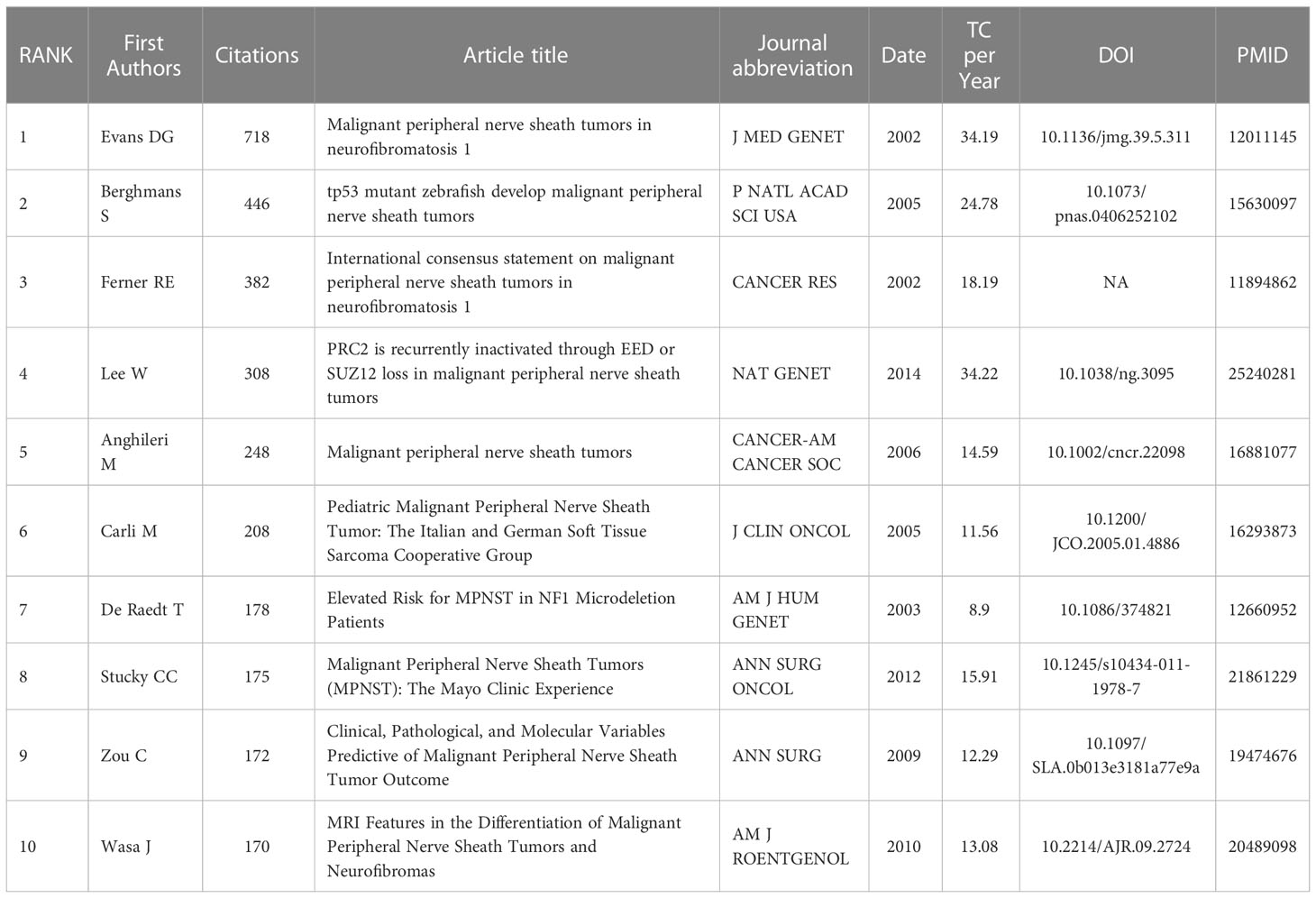- 1Center for Plastic & Reconstructive Surgery, Department of Plastic and Reconstructive Surgery, Zhejiang Provincial People’s Hospital (Affiliated People’s Hospital, Hangzhou Medical College), Hangzhou, Zhejiang, China
- 2Cancer Center, Zhejiang University, Hangzhou, China
- 3State Key Laboratory of Fluid Power and Mechatronics Systems, School of Mechanical Engineering, Zhejiang University, Hangzhou, China
- 4Key Laboratory of Materials Processing and Mold, Zhejiang University, Zhengzhou, China
- 5Key Laboratory of 3D Printing Process and Equipment of Zhejiang Province, College of Mechanical Engineering, Zhejiang University, Hangzhou, China
- 6Department of Plastic and Reconstructive Surgery, Shanghai Ninth People’s Hospital, Shanghai Jiao Tong University School of Medicine, Shanghai, China
Background: Currently, malignant peripheral nerve sheath tumors (MPNST) are the subject of intense research interest. However, bibliometric studies have not been conducted in this field. The purpose of the study was to identify historical trends and presents a bibliometric analysis of the MPNST literature from 2000 to 2022.
Methods: For the bibliometric analysis, publications were retrieved from the Web of Science database based on the following search terms: [TI = (MPNST) OR TI= (malignant peripheral nerve sheath tumors) AND PY = (2000–2022)]. The following information was collected for each document: the publication trends and geographical distribution, important authors and collaboration, keyword distribution and evaluation, most popular journals, and most influential articles.
Results: We included 1400 documents for bibliometric analysis, covering five categories: 824 articles, 17 proceedings papers, 68 letters, 402 meeting abstracts, and 89 reviews. Corrections, editorials, book chapters, data papers, publications with expressed concerns, and retractions were excluded from our research.
Conclusion: Since 2000, the number of publications on MPNST has continuously increased. Among all countries that contributed to the MPNST research, the USA, Japan, and China were the three most productive countries. The journal Modern Pathology has the most publications on MPNST, while those in the Cancer Research journal were the most frequently cited. The University of Texas MD Anderson Cancer Center may be a good partner to collaborate with. Recent research trends in MPNST have focused on tumorigenesis, clinical management, and predictive biomarkers.
1 Introduction
Malignant peripheral nerve sheath tumors (MPNST) are highly aggressive soft-tissue sarcomas originating from peripheral nerves (1). Approximately 50% of patients with MPNST also have neurofibromatosis type 1 (NF1), often due to malignant transformation from plexiform neurofibroma (2, 3). Like most sarcomas, MPNST has a high probability of local recurrence and metastatic spread. Unfortunately, no targeted therapies have proven effective to date, resulting in a relatively poor prognosis (4).
Previous studies found that deletion of the CDKN2A gene is the most common secondary mutation based on NF1 loss, followed by TP53 mutation (3, 5). In addition, PRC2, SUZ12, and EED mutation is also frequently observed in MPNST, and loss of H3K27me3 contributes to MPNST progression (6). These clues reveal the potential treatment of BRD4 and BET inhibition in MPNST (7).
Many researchers have provided new insights into MPNST since the onset of the 20th century. Yearly, many articles are published about MPNST, exploring and demonstrating clinical management, the tumorigenesis mechanism, and candidate molecular targets. However, no bibliometric analyses of MPNST-related studies have been published to date. It is vital for researchers and surgeons to be aware of the qualitative and quantitative characteristics of influential research in MPNST so that they can contextualize their clinical practices and aid in shaping future research. As a result, we conducted a bibliometric analysis of the MPNST literature to provide narrative synthesis and evaluate research trends.
2 Materials and methods
2.1 Database and search strategy
Bibliometric analysis on MPNST was conducted using Web of Science (WOS) core data as of August 2022.
Research articles on MPNST in any language were identified by using the search terms [TI = (Malignant peripheral nerve sheath tumor OR MPNST) AND PY = (2000–2022)]. As part of our search optimization process, we checked that the title of every article was relevant to the research.
The data were downloaded and analyzed separately by two researchers, and in the event of any discrepancies, a third independent researcher was invited to reproduce and analyze the data and make the final decision with all authors (Figure 1).
2.2 Information extraction
After two researchers had reviewed the retrieved data independently, bibliometric analysis was conducted on all the retrieved documents using four different software packages:
1) A spreadsheet using Microsoft Excel 2019 was used to calculate the percentages and frequencies of published materials.
2) A visual analysis of the bibliometric networks was compiled using VOSviewer (version 1.6.18).
3) Citation metrics and the temporal distribution of the publications were determined using RStudio.
4) A keyword citation burst analysis was performed on CiteSpace.
2.3 Bibliometric indices
The H-index indicates that an author has published at least h papers relevant to the MPNST that have each been cited at least h times. The G-index gives more weight to highly cited articles, as the top G articles receive at least G2 citations. The M-index is calculated by dividing a researcher’s H-index by their academic age (years since the first publication).
3 Results
3.1 Overview of retrieved literature
A total of 1498 articles were identified from the WOS database, excluding those not written in English (25 articles). The composition of the retrieved literature based on document type is summarized in Table 1.
Among all the documents, articles (824, 55.1%) topped the list, followed by meeting abstracts (402, 26.84%). Others include review articles (89, 5.94%), letters (68, 4.54%), and proceedings paper (17,1.13%). Corrections, editorials, book chapters, data papers, publications with expressed concerns, and retractions were excluded from our research. Five document types are included: articles, reviews, meeting abstracts, conference proceedings, and letters. Consequently, 1400 articles met the criteria for inclusion.
3.2 Citation and publication trends over time
Table 2 presents statistics for MPNST research publications. Among the most productive years, 2018 had 104 documents, while 2000 (excluding 2022) only had 20 documents. Between 2002 and 2003, the number of publications grew at the fastest rate. A significant decline in article productivity was evident between 2014 and 2015. Article production in 2015 was more than 30% lower than in 2014. The number of published articles in the investigated period fluctuated, but overall, increased in trend. Table 2 shows the annual scientific publications and citations. Among the total citations, 2014 had the highest number with 1516, followed by 2002 with 1424. It is reasonable that recent articles, such as those published in 2022 and 2021, received fewer citations. According to a global review of the literature from the last two decades, the number of citations per article peaked in 2002 with an average of 67.81 citations per article.
3.3 Most influential authors
The MPNST research involved 6000 authors. It is interesting to note that only 19 publications have been written by a single author. Among the documents, 19 were single-authored publications, whereas the rest were multi-authored. Each article had 6.51 co-authors on average. As a result, 98.6% of MPNST researchers collaborated during their research. Based on publications and citations since 2000, the top 10 authors are listed in Table 3. Victor F Mautner (University Medical Center Hamburg-Eppendorf) tops the list with 38 articles, followed by Steven L. Carroll (Medical University of South Carolina) with 32 documents. Mautner’s H, G, and M indices were respectively 21, 30, and 1.05. The top three most cited authors were David H Gutmann (1121), Victor F Mautner (1090), and Christopher DM Fletcher (1059). From 2000–2008, Washington University dominated the MPNST research field, whereas the University of Texas MD Anderson Cancer Center has held the top position since 2009. VOSviewer was used to visualize authors, with a minimum of five documents and ten citations needed for an author to be considered (Figure 2). MPNST research was impacted by the teams of Arie Perry, Nancy Ratner, Melike Pekmezci, and Alexander J. Lazar.
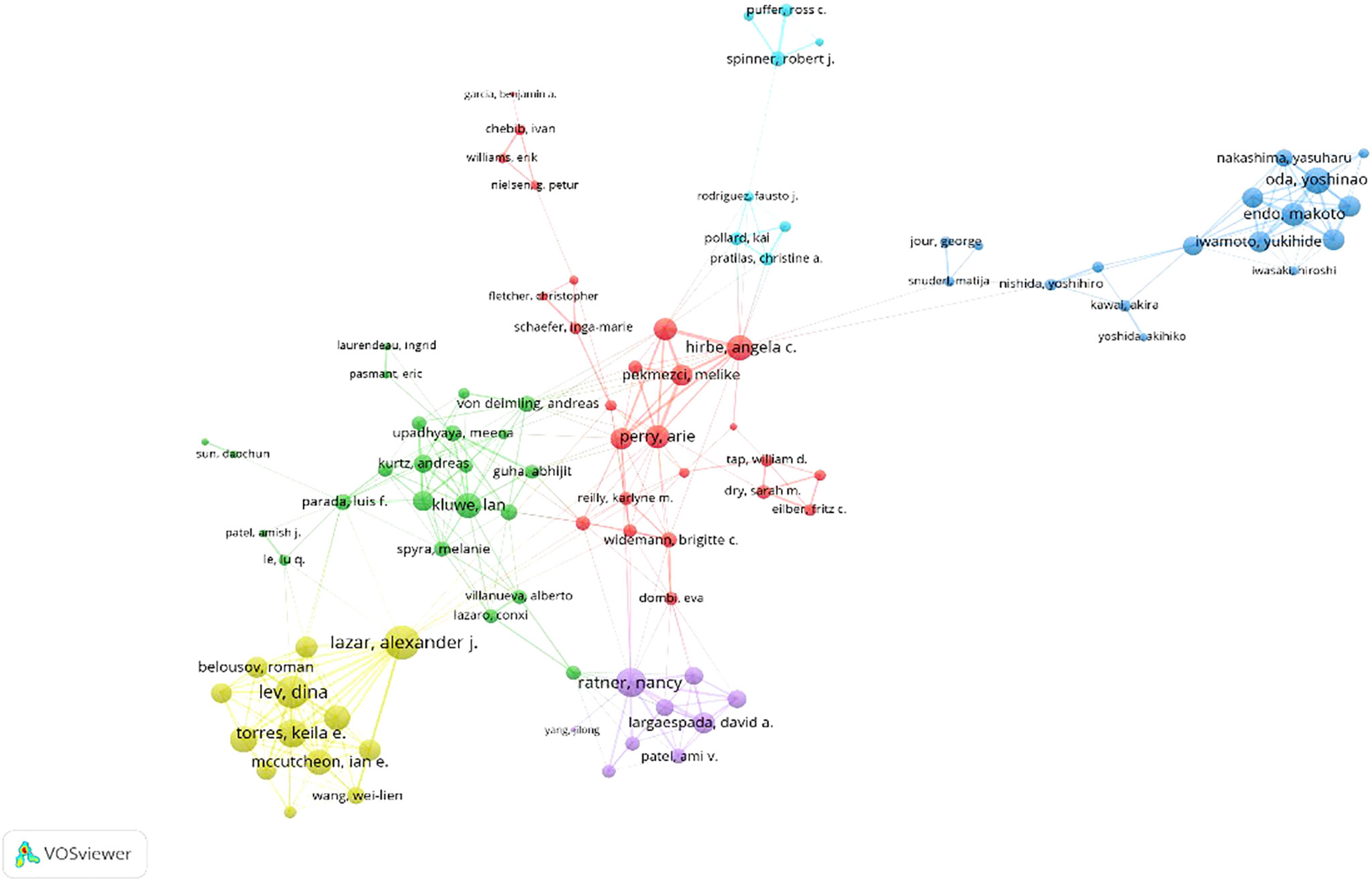
Figure 2 An overview of the co-authorship network in MPNST research VOSviewer.
3.4 Publications and citations across geographic regions
Contributions to the field of MPNST were made by scholars from 49 countries. As illustrated in Table 4, the top 10 countries with high production are listed. The USA ranked 1 with 573 articles, while Japan ranked second with 120. Figure 3 presents the distribution of articles wrote by single and multiple countries. Authors from several countries, such as Finland, New Zealand, Lebanon, and Slovenia, published articles cooperating with authors from multiple countries. In the most cited countries list, the USA gained the top spot with 8764 citations, followed by the United Kingdom with 2184 citations. On the other hand, considering citations for each article, the United Kingdom ranks first with 44.57 citations per article, and Norway is second with 33.67 citations per article. In Figure 4, the cooperation network between the countries is mapped. As one of the most important contributors to MPNST research, the USA has relatively frequent collaborations with China, Germany, Canada, and Japan. Despite India being ranked fifth in total citations, cooperation with other countries did not occur frequently.
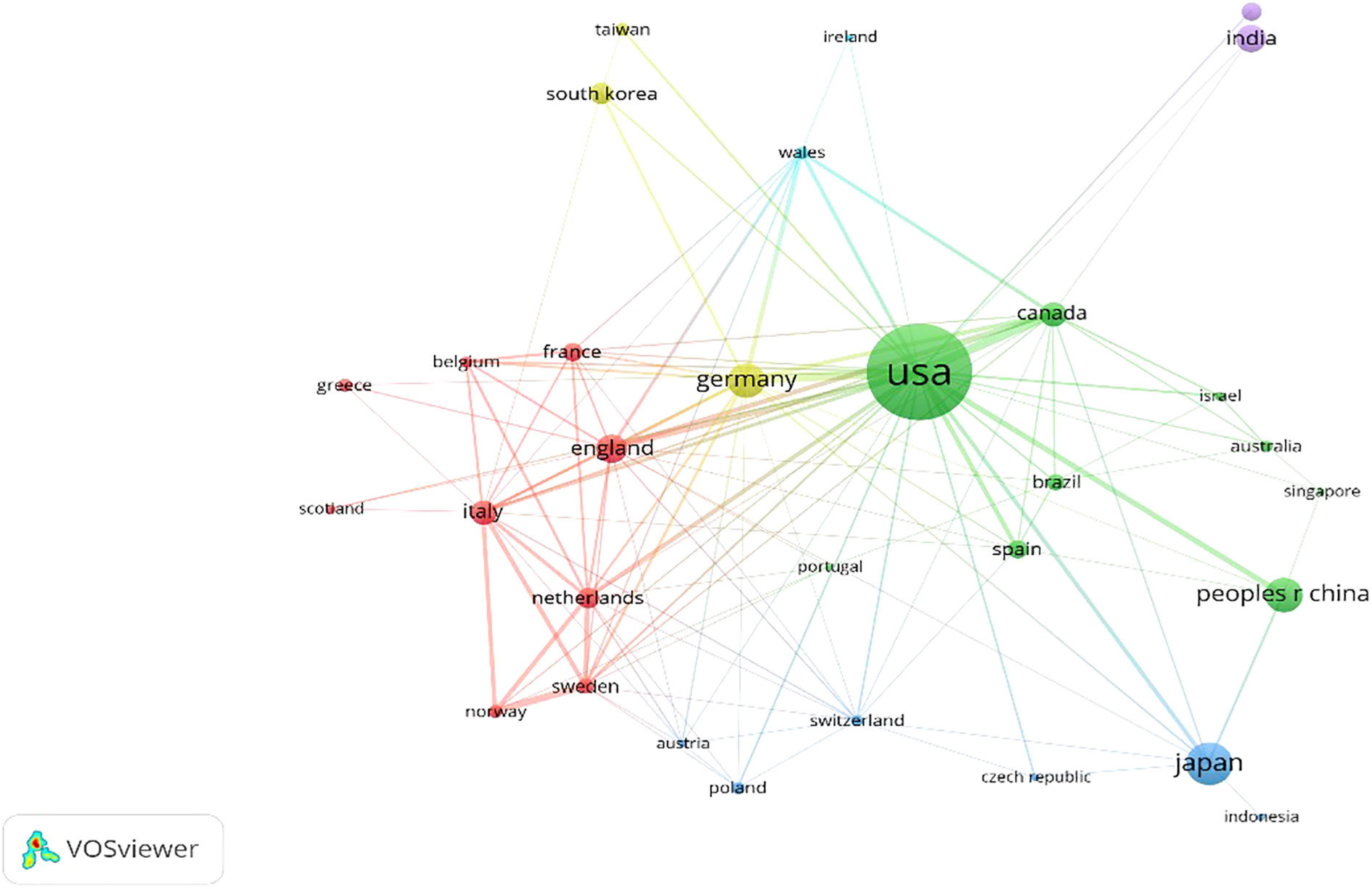
Figure 4 International collaboration network map. The widths of the connection lines indicate the collaboration strength. Countries with similar colors form a cluster VOSviewer.
3.5 Keyword analysis
3.5.1 Keywords hotspot
Keywords were calculated using RStudio from 1400 retrieved documents, resulting in 1509 author keywords (DE) and 1519 author keywords-plus (ID). The most frequently used author keywords (DE) were: “malignant peripheral nerve sheath tumor”, “MPNST”, “neurofibromatosis type 1”, “sarcoma”, “nf1”, “schwannoma”, “immunohistochemistry”, “chemotherapy”, “MRI”, and “radiotherapy”. The following hot keywords were included in the author keywords-plus (ID) group: “schwannoma”, “expression”, “survival”, “neurofibromatosis type 1”, “cancer”, “soft-tissue sarcomas”, “Schwann-cells”, “benign”, “gene”, and “management”. The frequency results are presented in Table 5.
3.5.2 Subdisciplines
As displayed in Figure 5, “malignant peripheral nerve sheath tumor”, “MPNST”, and “Schwannoma” are the author keywords that appear most frequently. A cluster analysis was conducted on keywords that met the selection criteria. Circles within the same color clusters indicate publications with similar topics. Specifically, the cluster of keywords in red (cluster 1,37) associated with the topic “neurofibromatosis type 1” includes the following: “Activation”, “Angiogenesis”, “Growth factor”, “Invasion”, “Mutation”, “Plexiform Neurofibroma”, “NF1 gene”, “Proliferation”, and “Ras”. The cluster of keywords in green (cluster 2,31) associated with the topic “Schwannoma” includes the following: “Chemotherapy”, “Doxorubicin”, “Head”, “Radiotherapy”, “Sarcoma”, “Surgery”, “Survival”. The blue cluster (cluster 3,23) included the keywords “Differentiation”, “F-18-fdg PET/CT”, “MRI”, “Neurofibroma”, “Trigeminal Nerve”, and “Triton Tumor” associated with the topic “malignant peripheral nerve sheath tumor”. Keywords in the yellow cluster (cluster 4,18) such as “Methylation”, “PRC2”, “S-100 Protein”, “SOX10”, and “SUZ12” were associated with the topic “Expression”. The top 10 keywords for the last two decades can be seen in Figure 6. Recently, the keyword “PRC2” has been the most cited.
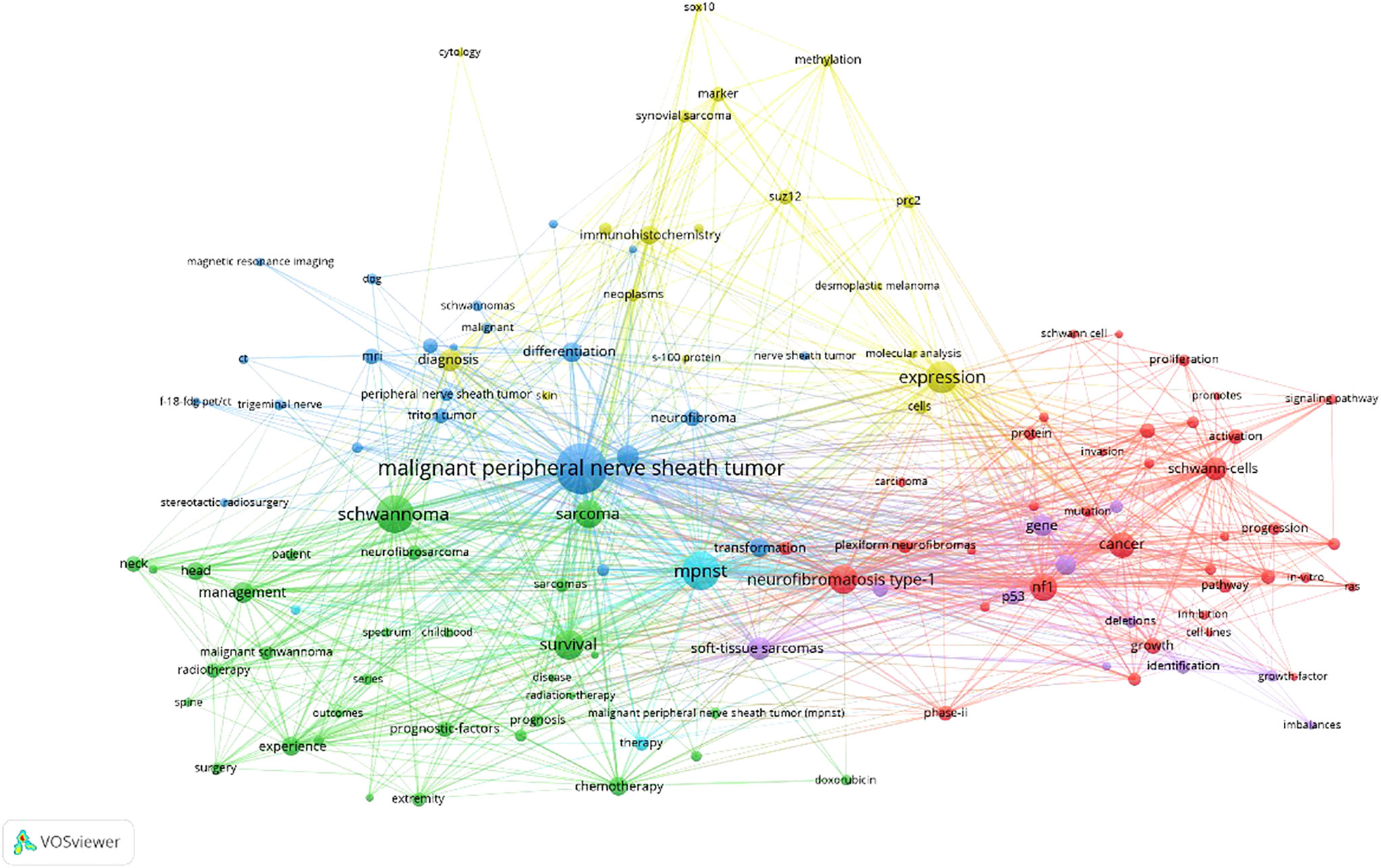
Figure 5 The authors’ keywords are visualized in a network map. Keywords with similar colors form a cluster VOSviewer.
3.6 Preferred journals
A list of the top 10 MPNST journals, ranked by number of publications and total citations, is presented in Table 6. Modern Pathology ranked the highest, with 69 articles. Having published 56 articles, Laboratory Investigation was the second most popular journal, followed by Cancer Research with 50 articles. According to the 2021 JCR report, Modern Pathology, Laboratory Investigation, and Cancer Research are all included in journal impact factors (JIF) quartile Q1. Despite having an IF of 50.717 and being included in Q1, Journal of Clinical Oncology did not dominate MPNST research. As the most cited journal in MPNST research, Cancer Research recorded 822 citations with an H-index of 9. The Journal of Medical Genetics ranked second with only 4 articles, while the American Journal of Surgical Pathology ranked third with 749 citations and 14 articles. However, Modern Pathology had the lowest average citations, despite being the most popular journal. As illustrated in Figure 7, Modern Pathology held a dominant position during the investigated period.
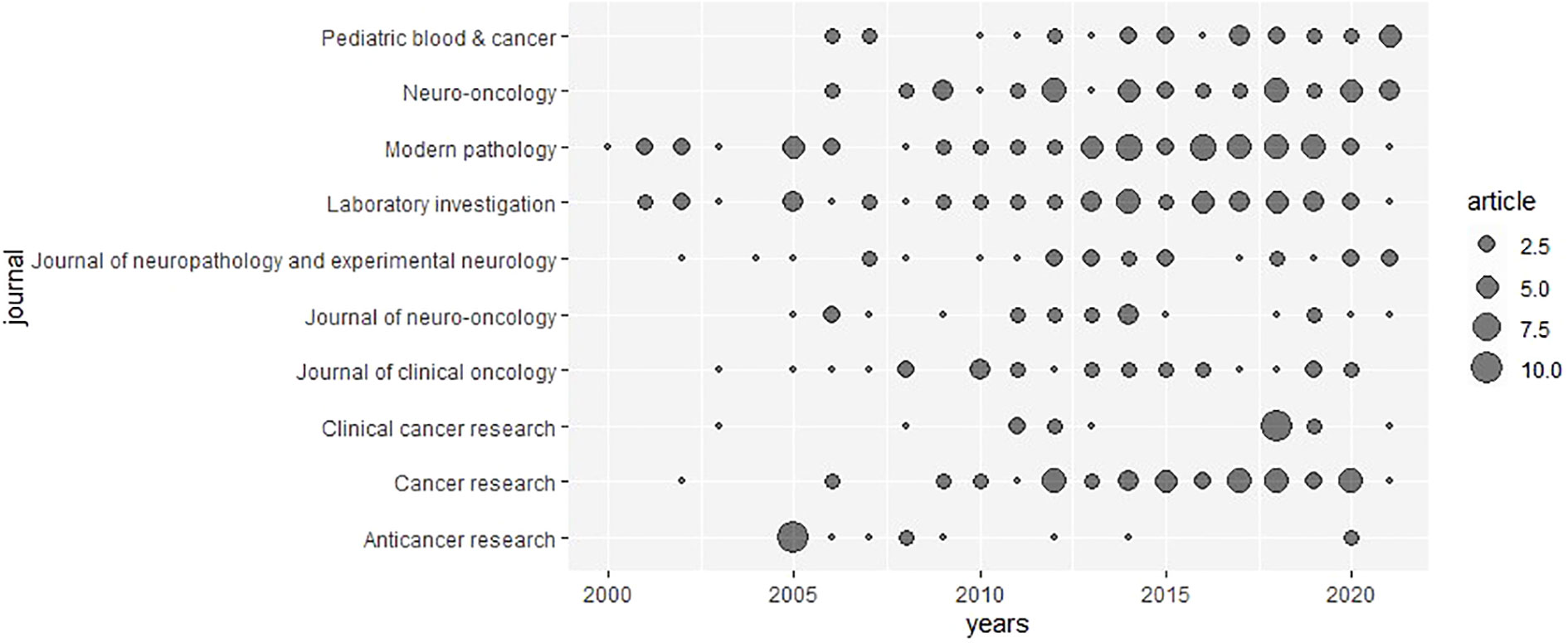
Figure 7 A visual representation of the chronological distribution of the publications from the top 10 most prolific journals.
3.7 Highly cited articles
Table 7 shows the top 10 most cited articles in the MPNST field, along with the top three cited articles.
1) “Malignant peripheral nerve sheath tumors in neurofibromatosis 1” (2002): There is a well-known association between MPNST and NF1. It has been reported that 1-2% of NF1 patients develop MPNST in cross-sectional studies, but population-based longitudinal studies that assess lifetime risk were before missing. Evans et al. first reported the 8–13% lifetime risk for NF1 patients of developing MPNST based on longitudinal studies. In addition, they found a worse prognosis in NF1-MPNST compared with sporadic MPNST (8).
2) “tp53 mutant zebrafish develop malignant peripheral nerve sheath tumors” (2005): Berghmans et al. first reported that zebrafish lacking tp53 spontaneously develop MPNST. Furthermore, they observed that animals with DNA damage had reduced apoptosis and cell-cycle arrest responses. The results indicate that tp53 may play a tumor-suppressing role in the wild-type fish, and tp53 mutation may contribute to MPNST tumorigenesis (9).
3) “International consensus statement on malignant peripheral nerve sheath tumors in neurofibromatosis” (2002): A consensus summary of MPNST in NF1 was presented by the multidisciplinary group for MPNST and NF1. They emphasized the importance of establishing an international database and standardized recording. They also noticed advances made with PET scanning and molecular genetics in MPNST. Moreover, multidisciplinary teams can bring benefits to MPNST management (10).
The top 10 most cited articles are mainly focused on molecular change in tumorigenesis and clinical management, which indicate that those topics were hot in MPNST research.
3.8 Most contributing institutions
The majority of the influential institutions are in the USA. The top ten most productive institutions are The University of Texas MD Anderson Cancer Center, Washington University, University of Alabama Birmingham, Mayo Clinic, Memorial Sloan Kettering Cancer Center, University of California-San Francisco, University of California-Los Angeles, Kyushu University, and University of Cincinnati. Despite publishing many articles, Kyushu University lacks strong cooperation in scientific research. The University of Texas MD Anderson Cancer Center is a significant collaborator in MPNST research (Figure 8).
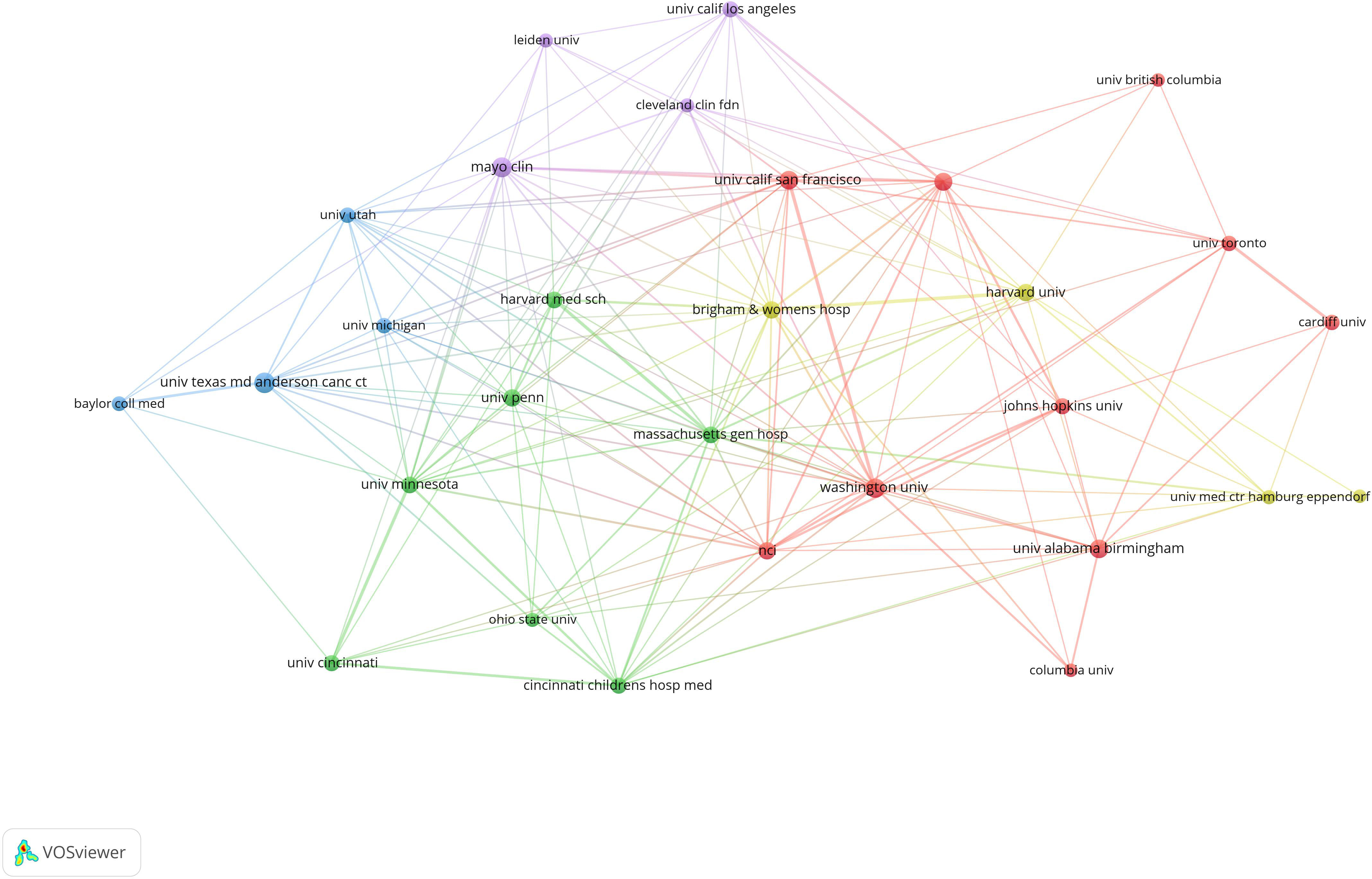
Figure 8 Visualization of collaborations between institutions VOSviewer.
4 Discussion
An analysis of bibliometric indicators indicated the research trends in this area and enabled the detection of changes, which will not only provide scientific guidance for future research work but also help us understand more about MPNST recently. The present study investigated 1400 publications from 2000 to 2022. As a relatively rare tumor, it is not surprising that few papers have been published on MPNST. However, inspiringly, the number of published articles has significantly increased. Compared to 2000, the number of articles published in 2021 is about five times higher. Consequently, the field of MPNST is currently gaining research attention. There was a downward trend in the average number of citations per article in MPNST, but this is not an accurate representation of article quality. Citations are more likely to increase with longer time after publication.
Among MPNST researchers, American authors dominate both article production and citations. However, Mautner (University Medical Center Hamburg-Eppendorf) was the author who published the most articles and received the most citations. What is more, he also led the H-index, G-index, and M-index. Clearly, his research has been highly productive as well as profound in its impact. Carroll and Perry are the second and third most productive authors. Among the top 10 high-impact authors, two are from University Medical Center Hamburg-Eppendorf, and two are from the University of California-San Francisco. Research in MPNST has been greatly enriched by those institutions.
With regards to number of publications, the USA dominates the list by a long way. In addition, they have the most experience in multi-country cooperation. Among the top 10 most productive countries, India and Korea are most likely to publish research by authors from a single country. It is likely that this multi-country collaborative research will become a trend and make a more significant contribution to MPNST research in the future.
Modern Pathology published 69 MPNST articles leading all other journals. Cancer Research received 877 citations and was the top-cited journal, while PNAS had the highest average citations per publication (237.50) with only two publications on MPNST. That is mainly attributed to the article titled “tp53 mutant zebrafish develop malignant peripheral nerve sheath tumors” published in PNAS in 2005. This article was cited 446 times and has become the second most cited MPNST article since 2000. It is encouraging to note that by analyzing the productive and highly cited journals in MPNST, we found that most of the top 10 journals in MPNST are in the JIF Q1 division, including well-known and influential journals like Nature Genetics (IF: 41.307) and Journal of Clinical Oncology> (IF:50.717). As a result, much attention is being focused on MPNST-related research.
Compared to other bibliometric analyses in oncology (11–13), most of the research also analyzed the productive authors, relevant institutions, preferred journals, and high-citation articles to summarize the research trend. However, MPNST is a relatively rare tumor and a gain of knowledge from a small number of cases is limited. Institutions focused on the treatment of MPNST have the advantage of more extensive clinical data and biobanking. Cooperation with those outstanding institutions could be helpful. MPNST research led and influenced by these institutions will probably be the trend and will help to further discover the pathogenesis and predictive factors important for the prognosis in this rare disease.
5 Hotspots and frontiers
Using neutral conjunction of top keywords and literature, the following research hotspots were identified:
1) Tumorigenesis in MPNST: MPNST still lacks a specific treatment because its mechanisms are unclear. Thus, finding the trigger genes for MPNST tumorigenesis is vital for discovering new therapies. Berghmans et al. demonstrated in 2005 that mutant tp53 zebrafish develop MPNST, and this paper became the second most cited publication in MPNST since 2000 (9). Lee et al. found PRC2 is recurrently inactivated through EED or SUZ12 loss in MPNST (6). Patel discovered that inhibition of the BET bromodomain triggers apoptosis in MPNST (14).
2) Clinical management: De Raedt et al. observed that NF1 microdeletion patients have an elevated risk of MPNST (2), and Tucker et al. reported a similar trend (15). Zou et al. analyzed 140 MPNST patients (72 were NF1-related, 68 were sporadic) and found MPNST ≥10 cm at diagnosis, partial resection, and metastasis development were significant negative predictors (16). Mautner et al. showed the difference in MRI between neurofibroma and MPNST (17). Warbey et al. indicated the value of [F-18]FDG PET/CT in diagnosing MPNST (18). Hagel et al. found patients were significantly younger at diagnosis (p < 0.001) and had a significantly shorter survival time than sporadic patients (19).
3) Predictive biomarkers: Zhang et al. performed genome-wide or targeted sequencing on 50 cases. Of the 50 cases, 16 MPNSTs but none of the neurofibromas tested were found to have somatic mutations in SUZ12, implicating it as having a central role in malignant transformation (20). Prieto-Granada et al. assessed 68 MPNST biospecimens and concluded that H3K27me3 has good sensitivity and robust specificity for diagnosing MPNST (21). Endo et al. found that p-mTOR and p-S6RP were both indicators of poor prognosis (22).
6 Strengths and limitations
The bibliometric analysis helped improve understanding the research trends and hot spots in MPNST, and the visual presentation clarified the collaboration between authors and institutions. Moreover, our analysis of hotspot burst time and highly cited articles will provide further insights into the MPNST research and guide future research (Figure 6). Despite its strengths, the study does have some limitations. First, unless an article is included in the WOS database, it will not be included in this analysis. Since this analysis is based on the WOS database, more convenience is provided, but some of the detail was sacrificed in the process. Additionally, we searched for articles containing MPNST in the title, so some MPNST research publications might be overlooked if the term does not appear in their titles. The suggestion of cooperation institutions should not simplify ranked by the number of publications or citations, because each institution has respective interests, strengths and weaknesses. The recommendation needs to be judged upon the situation.
7 Conclusion
A steady increase in the number of publications on MPNST was observed from 2000 to 2022. The most influential author is Mautner (University Medical Center Hamburg-Eppendorf). The USA, Japan, and China were the three most productive countries. The journal Modern Pathology features the most MPNST publications, while those in the journal Cancer Research were the most frequently cited. The University of Texas MD Anderson Cancer Center may be a good partner to collaborate with. Recent research trends in MPNST have focused on tumorigenesis, clinical management, and predictive biomarkers.
Data availability statement
The original contributions presented in the study are included in the article/supplementary material. Further inquiries can be directed to the corresponding authors.
Author contributions
CG and XjH designed the experiments; XfH and ZF performed the Bibliometric Analysis; QG and SW check the data; JW and YS performed visualization in data; XfH wrote this manuscript. All authors contributed to the article and approved the submitted version.
Funding
This research received grant from Zhejiang Provincial Health Science and Technology Program (2022KY511) (2023KY527) (2023KY031) and Outstanding Scientific Research Start-up Fund of Zhejiang Provincial People’s Hospital (ZRY2021C013) (ZRY2021A001). This research was also supported by Zhejiang Provincial Natural Science Foundation of China under Grant No. LQ22H160020 and No. LGF21H150004.
Conflict of interest
The authors declare that the research was conducted in the absence of any commercial or financial relationships that could be construed as a potential conflict of interest.
Publisher’s note
All claims expressed in this article are solely those of the authors and do not necessarily represent those of their affiliated organizations, or those of the publisher, the editors and the reviewers. Any product that may be evaluated in this article, or claim that may be made by its manufacturer, is not guaranteed or endorsed by the publisher.
References
1. Reilly K, Kim A, Blakely J, Ferner R, Gutmann D, Legius E, et al. Neurofibromatosis type 1-associated MPNST state of the science: Outlining a research agenda for the future. J Natl Cancer Inst (2017) 109(8). doi: 10.1093/jnci/djx124
2. De Raedt T, Brems H, Wolkenstein P, Vidaud D, Pilotti S, Perrone F, et al. Elevated risk for MPNST in NF1 microdeletion patients. Am J Hum Genet (2003) 72(5):1288–92. doi: 10.1086/374821
3. Nielsen GP, Stemmer-Rachamimov AO, Ino Y, Moller MB, Rosenberg AE, Louis DN, et al. Malignant transformation of neurofibromas in neurofibromatosis 1 is associated with CDKN2A/p16 inactivation. Am J Pathol (1999) 155(6):1879–84. doi: 10.1016/S0002-9440(10)65507-1
4. Stucky C-CH, Johnson KN, Gray RJ, Pockaj BA, Ocal IT, Rose PS, et al. Malignant peripheral nerve sheath tumors (MPNST): The Mayo clinic experience. Ann Surg Oncol (2011) 19(3):878–85. doi: 10.1245/s10434-011-1978-7
5. Rhodes Steven D, He Y, Smith A, Jiang L, Lu Q, Mund J, et al. Cdkn2a (Arf) loss drives NF1-associated atypical neurofibroma and malignant transformation. Hum Mol Genet (2019) 28(16):2752–62. doi: 10.1093/hmg/ddz095.
6. Lee W, Teckie S, Wiesner T, Ran L, Prieto Granada CN, Lin M, et al. PRC2 is recurrently inactivated through EED or SUZ12 loss in malignant peripheral nerve sheath tumors. Nat Genet (2014) 46(11):1227–32. doi: 10.1038/ng.3095
7. De Raedt T, Beert E, Pasmant E, Luscan A, Brems H, Ortonne N, et al. PRC2 loss amplifies ras-driven transcription and confers sensitivity to BRD4-based therapies. Nature (2014) 514(7521):247–51. doi: 10.1038/nature13561
8. Evans D, Baser M, McGaughran J, Sharif S, Howard E, Moran A. Malignant peripheral nerve sheath tumours in neurofibromatosis 1. J Med Genet (2002) 39(5):311–4. doi: 10.1136/jmg.39.5.311
9. Berghmans S, Murphey R, Wienholds E, Neuberg D, Kutok J, Fletcher C, et al. tp53 mutant zebrafish develop malignant peripheral nerve sheath tumors. Proc Natl Acad Sci USA (2005) 102(2):407–12. doi: 10.1073/p.nas.0406252102
10. Ferner R, Gutmann D. International consensus statement on malignant peripheral nerve sheath tumors in neurofibromatosis. Cancer Res (2002) 62(5):1573–7.
11. Millagaha Gedara N, Xu X, DeLong R, Aryal S, Jaberi-Douraki M. Global trends in cancer nanotechnology: A qualitative scientific mapping using content-based and bibliometric features for machine learning text classification. Cancers (2021) 13(17). doi: 10.3390/cancers13174417
12. Zhang D, Zhu W, Guo J, Chen W, Gu X. Application of artificial intelligence in glioma researches: A bibliometric analysis. Front Oncol (2022) 12:978427. doi: 10.3389/fonc.2022.978427
13. Zhang Y, Zhang X, Wang X, Han D, Du J. Visual analysis of global research output of lymphedema based on bibliometrics. Front Oncol (2022) 12:926237. doi: 10.3389/fonc.2022.926237
14. Patel A, Liao C, Chen Z, Liu C, Wang Y, Le L. BET bromodomain inhibition triggers apoptosis of NF1-associated malignant peripheral nerve sheath tumors through bim induction. Cell Rep (2014) 6(1):81–92. doi: 10.1016/j.celrep.2013.12.001
15. Tucker T, Wolkenstein P, Revuz J, Zeller J, Friedman J. Association between benign and malignant peripheral nerve sheath tumors in NF1. Neurology (2005) 65(2):205–11. doi: 10.1212/01.wnl.0000168830.79997.13
16. Zou C, Smith KD, Liu J, Lahat G, Myers S, Wang WL, et al. Clinical, pathological, and molecular variables predictive of malignant peripheral nerve sheath tumor outcome. Ann Surg (2009) 249(6):1014–22. doi: 10.1097/SLA.0b013e3181a77e9a
17. Mautner V, Friedrich R, von Deimling A, Hagel C, Korf B, Knöfel M, et al. Malignant peripheral nerve sheath tumours in neurofibromatosis type 1: MRI supports the diagnosis of malignant plexiform neurofibroma. Neuroradiology (2003) 45(9):618–25. doi: 10.1007/s00234-003-0964-6
18. Warbey V, Ferner R, Dunn J, Calonje E, O’Doherty M. [18F]FDG PET/CT in the diagnosis of malignant peripheral nerve sheath tumours in neurofibromatosis type-1. Eur J Nucl Med Mol Imaging (2009) 36(5):751–7. doi: 10.1007/s00259-008-1038-0
19. Hagel C, Zils U, Peiper M, Kluwe L, Gotthard S, Friedrich R, et al. Histopathology and clinical outcome of NF1-associated vs. sporadic malignant peripheral nerve sheath tumors. J neuro-oncol (2007) 82(2):187–92. doi: 10.1007/s11060-006-9266-2
20. Zhang M, Wang Y, Jones S, Sausen M, McMahon K, Sharma R, et al. Somatic mutations of SUZ12 in malignant peripheral nerve sheath tumors. Nat Genet (2014) 46(11):1170–2. doi: 10.1038/ng.3116
21. Prieto-Granada C, Wiesner T, Messina J, Jungbluth A, Chi P, Antonescu C. Loss of H3K27me3 expression is a highly sensitive marker for sporadic and radiation-induced MPNST. Am J Surg Pathol (2016) 40(4):479–89. doi: 10.1097/PAS.0000000000000564
22. Endo M, Yamamoto H, Setsu N, Kohashi K, Takahashi Y, Ishii T, et al. Prognostic significance of AKT/mTOR and MAPK pathways and antitumor effect of mTOR inhibitor in NF1-related and sporadic malignant peripheral nerve sheath tumors. Clin Cancer Res (2013) 19(2):450–61. doi: 10.1158/1078-0432.CCR-12-1067
Keywords: bibliometric analysis, malignant peripheral nerve sheath tumors, cancer, VOSviewer, RStudio
Citation: Huang X, Fu Z, Gu Q, Wang J, Sun Y, He Y, Wu S, Hu X and Guo C (2023) A worldwide bibliometric analysis of malignant peripheral nerve sheath tumors from 2000 to 2022. Front. Oncol. 13:1111985. doi: 10.3389/fonc.2023.1111985
Received: 30 November 2022; Accepted: 05 January 2023;
Published: 27 January 2023.
Edited by:
Carsten Friedrich, Klinikum Oldenburg AöR, GermanyReviewed by:
Andrea Carai, Bambino Gesù Children’s Hospital (IRCCS), ItalyRishan Thimma Sudarsan, Gleneagles Global Health City, India
Copyright © 2023 Huang, Fu, Gu, Wang, Sun, He, Wu, Hu and Guo. This is an open-access article distributed under the terms of the Creative Commons Attribution License (CC BY). The use, distribution or reproduction in other forums is permitted, provided the original author(s) and the copyright owner(s) are credited and that the original publication in this journal is cited, in accordance with accepted academic practice. No use, distribution or reproduction is permitted which does not comply with these terms.
*Correspondence: Xiaojie Hu, aHhqaWUyMDAyQGhvdG1haWwuY29t; Chengrui Guo, Z2NydWkyMDExQGhvdG1haWwuY29t
†These authors have contributed equally to this work
 Xingfeng Huang1†
Xingfeng Huang1† Ji Wang
Ji Wang Chengrui Guo
Chengrui Guo